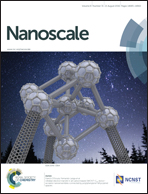Building robust architectures of carbon-wrapped transition metal nanoparticles for high catalytic enhancement of the 2LiBH4-MgH2 system for hydrogen storage cycling performance†
Abstract
Nanoscale catalyst doping is regarded as one of the most effective strategies to improve the kinetics performance of hydrogen storage materials, but the agglomeration of nanoparticles is usually unavoidable during the repeated de/rehydrogenation processes. Herein, hierarchically structured catalysts (Fe/C, Co/C and Ni/C) were designed and fabricated to overcome the agglomeration issue of nanocatalysts applied to the 2LiBH4-MgH2 system for the first time. Uniform transition metal (TM) nanoparticles (∼10 nm) wrapped by few layers of carbon are synthesized by pyrolysis of the corresponding metal–organic frameworks (MOFs), and introduced into the 2LiBH4-MgH2 reactive hydride composites (RHCs) by ball milling. The particular features of the carbon-wrapped architecture effectively avoid the agglomeration of the TM nanoparticles during hydrogen storage cycling, and high catalysis is maintained during the subsequent de/rehydrogenation processes. After de/rehydrogenation cycling, FeB, CoB and MgNi3B2 can be formed as the catalytically active components with a particle size of 5–15 nm, which show a homogeneous distribution in the hydride matrix. Among the three catalysts, in situ-formed MgNi3B2 shows the best catalytic efficiency. The incubation period of the Fe/C, Co/C and Ni/C-doped 2LiBH4-MgH2 system between the two dehydrogenation steps was reduced to about 8 h, 4 h and 2 h, respectively, which is about 8 h, 12 h and 14 h shorter than that of the undoped 2LiBH4-MgH2 sample. In addition, the two-step dehydrogenation peak temperatures of the Ni/C-doped 2LiBH4-MgH2 system drop to 323.4 °C and 410.6 °C, meanwhile, the apparent activation energies of dehydrogenated MgH2 and LiBH4 decrease by 58 kJ mol−1 and 71 kJ mol−1, respectively. In particular, the cycling hydrogen desorption of the Ni/C-doped 2LiBH4-MgH2 sample exhibits very good stability compared with the undoped sample. The present approach, which ideally addresses the agglomeration of nanoparticles with efficient catalysis on the RHCs, provides a new inspiration to practical hydrogen storage application for high performance complex hydrides.


 Please wait while we load your content...
Please wait while we load your content...